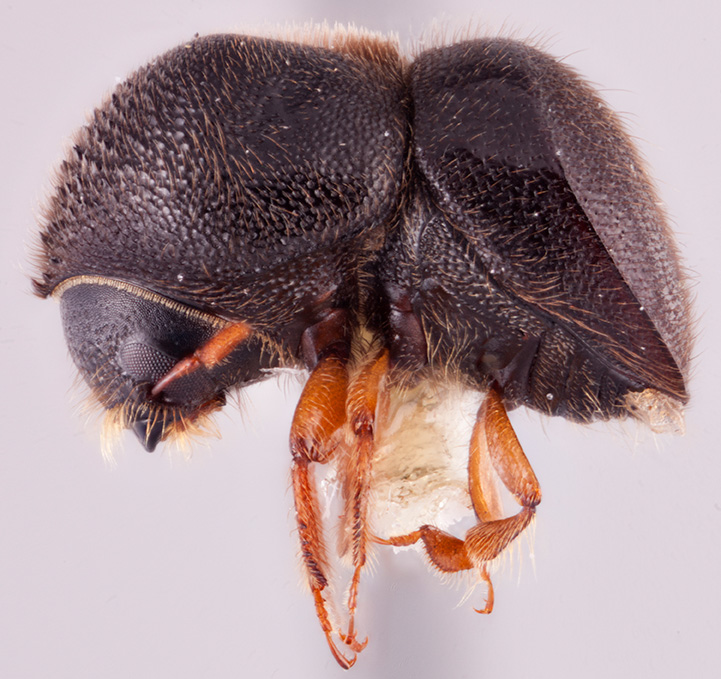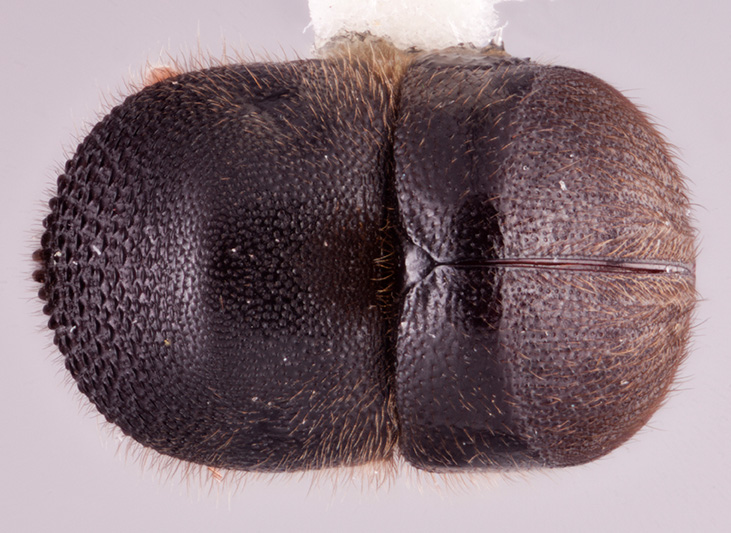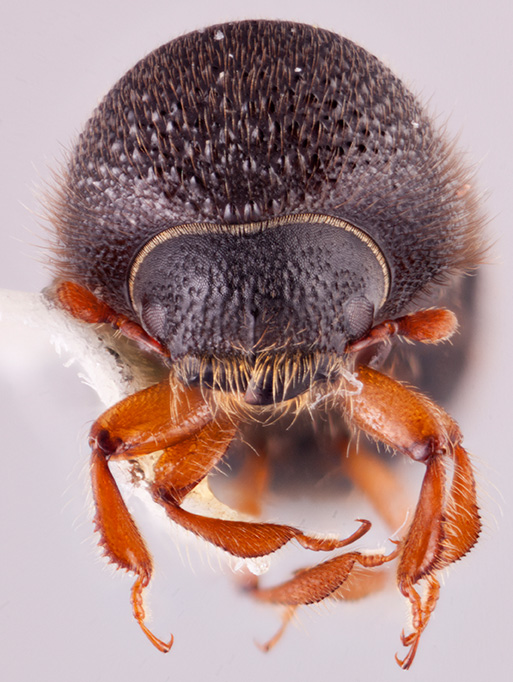Cnestus mutilatus
|
Cnestus mutilatus lateral; R.K. Osborn |
|
Cnestus mutilatus dorsal; R.K. Osborn |
|
Cnestus mutilatus declivity; R.K. Osborn |
|
Cnestus mutilatus frontal; R.K. Osborn
|
Taxonomic history
Xyleborus mutilatus Blandford, 1894b: 103.
Xylosandrus mutilatus (Blandford): Wood, 1989: 177.
Cnestus mutilatus (Blandford): Dole and Cognato, 2010: 530.
Synonyms
Xyleborus sampsoni Eggers, 1930: 184. Wood, 1989: 177.
Xyleborus taitonus Eggers, 1939b: 118. Wood and Bright, 1992: 799.
Xyleborus banjoewangi Schedl, 1939b: 41. Kalshoven, 1960: 63.
Diagnosis
3.6−3.8 mm long (mean = 3.76 mm; n = 5); 1.58−1.73 times as long as wide. This species can be distinguished by the presence of a mesonotal mycangial tuftmycangial tuft:
tuft of setae that denotes the mycangia exterior opening
 on the pronotalpronotal:
on the pronotalpronotal:
pertaining to the pronotum
basebase:
point or edge closest to the body; opposite of apex ; elytralelytral:
; elytralelytral:
pertaining to the elytra
discdisc:
the flat central upper surface of any body part (e.g. pronotum and elytra) very short, two times scutellumscutellum:
very short, two times scutellumscutellum:
a shield-like sclerotized plate located at the midpoint of the elytral base
length; elytralelytral:
pertaining to the elytra
declivitydeclivity:
downward slope of either the pronotum or elytra
 , obliquely truncateobliquely truncate:
, obliquely truncateobliquely truncate:
nearly truncate but rounded not flat in lateral view
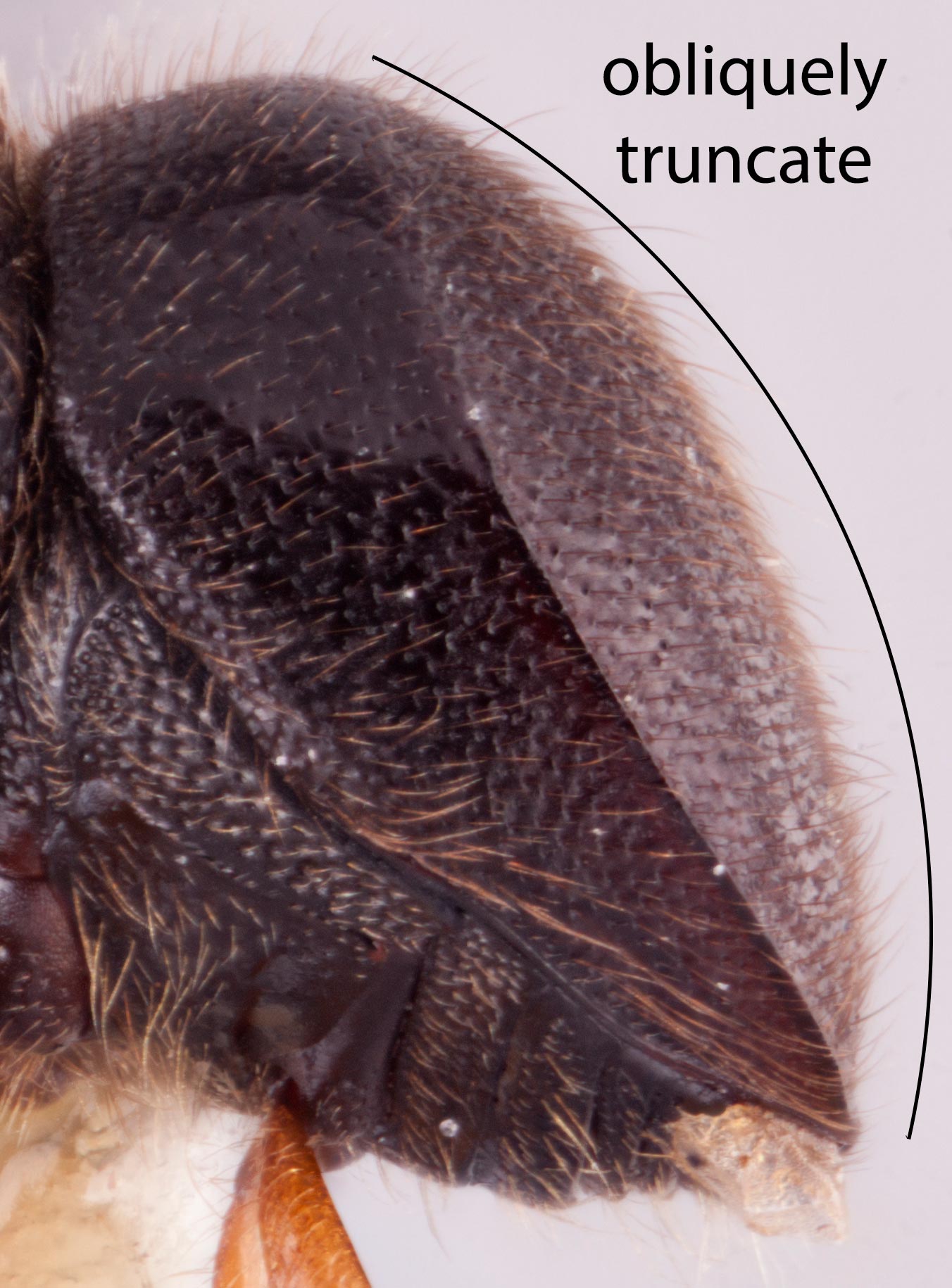 ; pronotumpronotum:
; pronotumpronotum:
the dorsal surface of the thorax
type 1 when viewed dorsally; antennalantennal:
pertaining to the antennae
club type 2, with two sutures visible on posteriorposterior:
toward the rear end; opposite of anterior
 face; antennalantennal:
face; antennalantennal:
pertaining to the antennae
funicle four-segmented; protibiaprotibia:
tibia of the first pair of legs
obliquely triangular; procoxae narrowly separated; posterolateralposterolateral:
relating to end of the side part/portion
 margin of elytraelytron:
margin of elytraelytron:
the two sclerotized forewings of beetles that protect and cover the flight wings
weakly carinate from apexapex:
point or edge furthest from the body; opposite of base
 to declivitaldeclivital:
to declivitaldeclivital:
pertaining to the elytral declivity
basebase:
point or edge closest to the body; opposite of apex along interstriaeinterstria:
along interstriaeinterstria:
longitudinal spaces along the elytra between the striae, which is not as<br />
impressed and bear smaller punctures.
 7; declivitaldeclivital:
7; declivitaldeclivital:
pertaining to the elytral declivity
interstriae granulategranulate:
pertaining to a coarse, grainy surface texture
 , setose with recumbentrecumbent:
, setose with recumbentrecumbent:
pertaining to setae that are flat against the cuticle
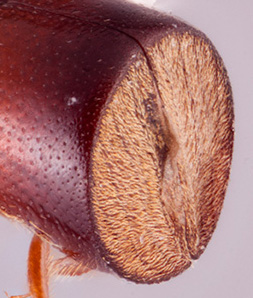 hairs and often median row of long erecterect:
hairs and often median row of long erecterect:
pertaining to setae that have their apices directed away from the body and appear straight
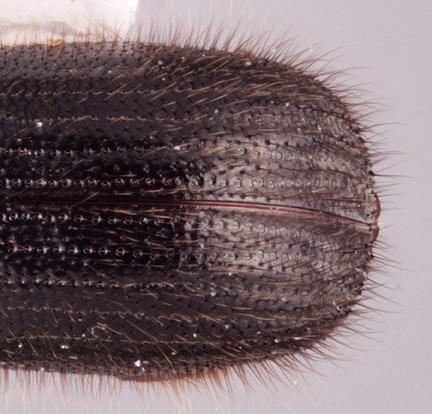 hairs (varies geographically); striaestria:
hairs (varies geographically); striaestria:
punctures in rows, which may or may not be impressed to make grooves 1 and 2 impressedimpressed:
1 and 2 impressedimpressed:
a depression in a surface
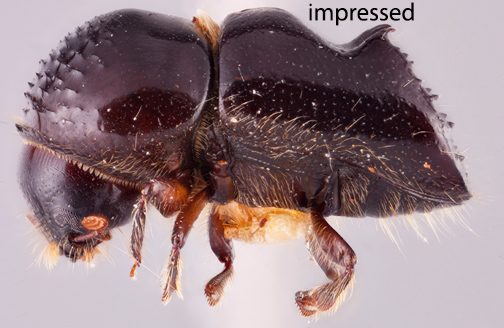 ; discaldiscal:
; discaldiscal:
pertaining to the disc of either the pronotum or elytra
punctures dense, confusedconfused:
of markings, having indefinite outlines or running together as lines or spots without definite pattern; usually referring to punctures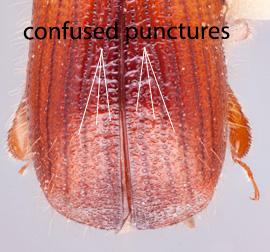 ; and uniformly black body.
; and uniformly black body.
May be confused with
Anisandrus ursulus, Cnestus gravidus, Cnestus improcerus, and C. testudo
Distribution
Throughout the Oriental region from India to Indonesia and New Guinea, and extending northwards to Japan, South Korea, and Russia (Far East). Introduced and established in the United States (Schiefer and Bright 2004Schiefer and Bright 2004:
Schiefer TL, Bright DE. 2004. Xylosandrus mutilatus (Blandford), an exotic ambrosia beetle (Coleoptera: Curculionidae: Scolytinae: Xyleborini) new to North America. The Coleopterists Bulletin 58: 431-438. https://doi.org/10.1649/760, Gomez et al. 2018a) and Europe (Italy) (Colombari et al. 2022Colombari et al. 2022:
Colombari F, Martinez-Santilde;udo I, Battisti A. 2022. First report of the alien ambrosia beetle Cnestus mutilatus and further finding of Anisandrus maiche in the European part of the EPPO region (Coleoptera: Curculionidae: Scolytinae: Xyleborini) EPPO Bulletin, 00, 1-5. Available from: https://doi.org/10.1111/epp.12840). Recorded in the study region from China (Anhui, Fujian, Guizhou, Hainan, Hong Kong, Jiangsu, Jiangxi, Shaanxi, Shanghai, Sichuan, Yunnan, Zhejiang), Japan, Korea, Taiwan, Thailand, Vietnam.
Host plants
polyphagous (Wood and Bright 1992Wood and Bright 1992:
Wood SL, Bright DE. 1992. A catalog of Scolytidae and Platypodidae (Coleoptera), Part 2: Taxonomic index. The Great Basin Naturalist Memoirs 13: 1-1533.)
Remarks
The biology of the species has been studied in Japan by Kajimura and Hijii (1992, 1994), in China by Tang (2000), and in U.S.A. by Stone and colleagues (Stone and Nebeker 2007Stone and Nebeker 2007:
Stone WD, Nebeker TE. 2007. Distribution and seasonal abundance of Xylosandrus mutilatus (Coleoptera: Curculionidae). Journal of Entomological Science 42: 409-412. https://doi.org/10.18474/0749-8004-42.3.409, Stone et al. 2007). The associated ambrosia fungus has been described by Six et al. (2009). It is a pest of young Castanea mollissima (Fagaceae) trees in China (Zhejiang) (Tang 2000Tang 2000:
Tang W-Q. 2000. Biological characteristics of Xyleborus mutilatus and its control. Journal of Zhejiang Forestry College 17: 417-420. (Chinese with English abstract)), but in USA appears to favor stressed host plants (Stone et al. 2007).
DNA data
Sequences available for COI and CAD.

